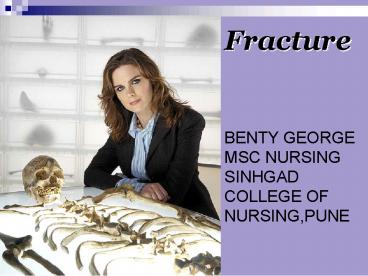Fracture - PowerPoint PPT Presentation
Title: Fracture
1
Fracture BENTY GEORGE MSC NURSING SINHGAD
COLLEGE OF NURSING,PUNE
2
Definition of Fracture
- Fracture A fracture is a break in the
continuity of the bone.
3
Etiology
- Motor Vehicle Accident
- Fall
- Direct blow to the bone or an indirect force from
muscle contraction - Sports
- Vigorous Exercise
- Malnutrition
- Bone Diseases like Osteoporosis
4
Types of Fracture
Fracture
5
Butterfly Fracture
- This type of fracture has slight comminution
at the fracture site
6
Closed Fracture
- There is no broken skin. The bones which are
broken do not penetrate the skin.
7
Compound Bone Fracture
- The skin is broken, leading directly into
fracture - Grade I Minimal soft tissue injury
- Grade II Laceration greater then 1cm without
extensive soft tissue flaps. - Grade III Extensive soft tissue injury,
including skin, muscles, neuro vascular
structures, with crushing.
8
Compression Fracture
- A fracture in which bone has been compressed.
9
Greenstick Fracture
- The fracture in which one side of the bone is
broken and the other side is bent.
10
Hairline Fracture
- In this type of the fracture the crack only
extends into the outer layer of the bone but not
completely through the entire bone. It is also
known as a Fissure Fracture.
11
Incomplete Fracture
- A fracture in which the end of the bone do not
completely separate leaving the bone with a crack
12
Multiple Fractures
- A bone with several fracture. It can also
mean several fractures in one patient but on
separate bones but generally due to the same
injury.
13
Oblique Fractures
- A fracture occurring at an angle across the
bone. It is an unstable fracture, it can be
easily diagnosed as spiral fracture.
14
Spiral Fractures
- A fracture twisting around the shaft of the
bone. It is highly unstable. It can be diagnosed
as oblique fracture unless a proper X-ray has
been taken.
15
Unstable Fracture
- An unstable fracture is generally a broken
bone which is comminuted, oblique or a spiral
fracture requiring external or internal fixation.
16
(No Transcript)
17
Sign and Symptoms of Fracture
- Arm and leg fractures
- 5 Ps Pain and point tenderness.
- Pallor
- Pulse loss
- Paresthesia
- Paralysis
- Deformity
- Swelling
- Discoloration
- Crepitus (grating, crackling or popping sounds )
- Loss of limb function
- Numbness
- Cool skin at the end of
- extremity
- Loss of pulse
18
- Skull Fracture
- Bleeding
- Hypertension
- Loss of consciousness
- Agitation
- Irritability
- Changes in responses
- Seizures
- Vomiting
- Facial ecchymosis
- CSF leakage from ears and nose
- Altered pupillary and motor
- responses
- Abrasion
- Laceration
19
- Jaw dislocation or fracture
- Mal occlusion
- Mandibular S/S Pain
- Swelling
- Ecchymosis
- Loss of
function - Asymmetry
- Paresthesia
of chin - and lower
lip - Maxillary S/S Infra orbital Paresthesia
- Nasal and
orbital fracture
20
Diagnostic Evaluation
- X-ray
- MRI, CT-scan
- Blood studies
- Arthroscopy
- Angiography
- Nerve conduction / electromyogram studies
21
Management of Fracture
- Assessment
- Type, location and severity of fracture
- Soft tissue damage
- Age and health status of patient
- Extend of other parts of organs
22
Approaches to Management
23
Closed reduction
- Is the most common non surgical method for
managing a simple fracture. - Bandages are elastic or muslin bandage used to
immobilize the bone during healing. - Splints as upper extremity bones do not bear
weight, splints may be sufficient to keep bone
fragments in place.
24
- Casts A cast is an immobilizing device made up
of layers of plaster or fiber glass. A cast also
allows early mobility and reduces pain. - Types of cast
- Arm cast
- Leg cast
- Cast braces
- Body or spica cast
25
- Traction its the application of a pulling
force to a part of the body. It uses a system of
ropes, pulleys, and weights to provide reduction,
alignment and rest.
26
Open reduction
- Internal fixation Open reduction with internal
fixation permits early mobilization. It is often
the preferred surgical method for an elderly
client who is susceptible to the complications of
immobility. Internal fixation uses pins, screws,
rods, plates and / or protheses to immobilize a
fracture during healing. After the bone achives
union, the hardware may be removed, depending on
the location and type of fracture.
27
- External fixation Open reduction with external
fixation. The physican makes small percutaneous
incisions so that pins may be implanted into the
bone. The pins are held in place by a large
external metal frame to help in bone healing.
28
Goals of management
- To regain and maintain correct position and
alignment. - To regain the function of involved part.
- To return the patient to usual activities in the
shortest time and at the least expenses.
29
Complications of Fracture
- Acute compartment syndrome.
- Shock.
- Fat embolism syndrome.
- Thrombo embolic complication.
- Infection.
- Avascular necrosis.
- Delayed union, non union and
- mal union.
30
QUESTIONS
- ?































